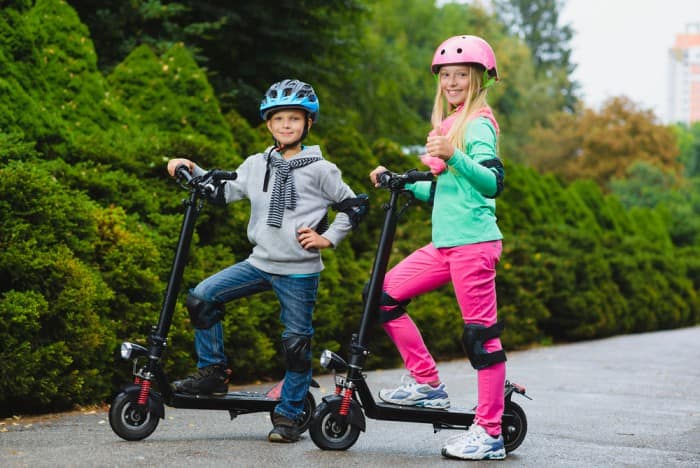
There’s no denying that most parents are incredibly protective of their kids; no one wants to see their child hurt, even if it’s from something as simple as falling off a bike or scooter. But as much as we want to protect our children, we need to be realistic about the benefits and drawbacks of activities such as riding scooters so we can better decide whether or not these are activities we want them to participate in. We don’t want them to grow up feeling deprived, after all; we want them to have happy and fun-filled childhoods.
With that in mind, we’ve put together this quick and easy article outlining some of the more notable benefits and drawbacks of buying scooters for your kids. We hope you find this helpful for deciding whether or not to buy a scooter for your own child, but also advise that you bear in mind that the points we list here are general information and suggestions, and as such might not apply to your own situation depending upon your child’s age, temperament, and so on.
Benefits
- Improve balance. Learning how to use a scooter can help your child improve their balance. This because while kicking off the ground is necessary to get moving, maintaining a consistent center of gravity and being able to balance is key to staying moving. Therefore, playing on a scooter can help your kids develop better balancing skills.
- Spend more time outdoors. There’s no denying that many children spend a lot of their time indoors these days, whether it’s playing video games or watching television. Getting them interested in more physical activities like riding scooters or bikes is good because it encourages them to get outside and get some fresh air. It’s not healthy to stay cooped up indoors all day, especially for a growing child, so in that regard using a scooter (which gets them outside and on the move) is definitely a benefit.
- Get more exercise. As mentioned earlier, many kids these days are spending more time inside and not getting outside as often as previous generation. While depriving them of fresh air and sunlight as we mentioned previously, this more sedentary lifestyle also hinders their ability to get sufficient exercise. Buying your child a scooter can help with this, because of the physical effort required to use the scooter. And not only does using a scooter for exercise help to make your kid physically stronger and healthier, it can also help boost their cognitive development as they grow.
- Develop motor skills. Using a scooter can help your child to better develop both their fine and gross motor skills. Gross motor skills are related to big movements and motions that a person can do, as well as hand-eye coordination, while fine motor skills refer to more precise movements. Both types of motor skills are important, and the use of a scooter can help a child to develop these skills more effectively because the operation of a scooter requires both good coordination and maneuvering (to keep from crashing into things) as well as the ability to physically get the scooter moving and steer it.
- Have fun. One of the most obvious benefits of using a scooter is, of course, that it is fun. Children can get hours of enjoyment out of using scooters, whether they’re just going along a flat sidewalk or going down a hill.
- Improve social skills. Encouraging your child to go outside and use their scooter can not only help them build up their motor skills and coordination skills, but their social skills as well. That’s because being out in the neighborhood while riding their scooter will likely result in them running into other kids their age. This leads to greater socialization and can potentially even result in long-term friendships forming.
Drawbacks
- Potential for injury. Like with all physical activities, riding a scooter comes with the inherent risk for injury. In this case, there is a chance that your child may fall off their scooter or crash into something if they lose control of it. Therefore, it’s important to make sure that they are wearing safety equipment whenever they ride their scooter. In particular, it’s important to make sure that they have a durable helmet at the very least, as well as knee pads and elbow pads if you want for them to have an extra level of protection in case something happens. You should also make sure that your child is wearing the proper footwear for using a scooter (such as tennis shoes or sneakers; don’t let them wear flip flops or sandals, since this could put them at risk for injuring their feet while riding the scooter). That being said, even the potential for injury can be a learning experience for children, because it can teach them the consequences of recklessness if they behave too wildly on their scooter.
- Limited area of use. Scooter are by design most effective on flat surfaces. Therefore, a child using a scooter is going to be restricted to flat surfaces like streets, sidewalks, and scooter-friendly areas in community parks; any locations with gravel or thick grass aren’t going to be very conducive to scooter-riding.
- Size and weight limitations. Scooters designed for children have very specific height and weight limitations; you will need to make sure to purchase a scooter that is the right size for your child. Furthermore, as your child grows they will likely need to upgrade to a larger scooter (using a scooter that is too small can increase the risk for injury).
Conclusion
Generally speaking, it is easy to see that the numerous potential benefits outweigh the potential drawbacks. That being said, you will ultimately need to decide for yourself whether or not buying a scooter for your child is a good idea. Either way, we hope that you’ve found our article helpful and informative.
